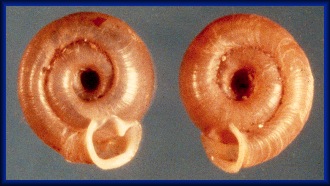Freaky Flatcoils |
|
By Harry G. Lee |
|
|
Figure 1. |
|
John D. MacArthur Beach State Park, Palm Beach, Co., Florida (14 mm.) |
|
Polygyra cereolus (Mühlfeld, 1816), also called the Southern Flatcoil,* is certainly the most ubiquitous landsnail in most of Florida. It achieves densities of thousands of living specimens per square meter - often in the most unpropitious (for most snails) situations. Particularly well-adapted to withstand fluctuations of temperature and humidity, colonies can prosper on roadsides, graveyards, lawns, drainage swales, often more than in traditional (moist and shaded) areas. Originally limited to the Coastal Plain of the American Southeast, its ability to exploit ruderal (stressed, usually altered by man) habitats has made it a bit of a pest, and it has consequently extended its range to remote parts of the country by transport on ornamental plants, etc. Quite variable in size and whorl-count, the shell of P. c. is usually in the range of a quarter inch, occasionally a lot more, placing it above the median size of our 67 native shelled landsnails. In our part of the U. S., the only species with which it might be confused is P. septemvolva (Say, 1818), the Florida Flatcoil, which Thomas Say named from specimens he collected at Picolata, St. Johns Co., on his 1817-18 East Florida expedition. The Florida is generally flatter, more widely-umbilicate, and possesses more whorls than the Southern Flatcoil; it is often as abundant. There are occasional intergrades, however. As Phil Poland and Mariette Jearey independently concluded in the May-June Shell-O-Gram, the kind of population dynamics and habitat preference exhibited by P. cereolus are favorable for the appearance (and collection) of anomalous specimens. Well, two such sports have come to our attention. A sinistral specimen was collected by Wayne Sullivan in Desoto Park, Manatee Co. in 1986. I was able to examine and photograph it shortly afterward (see Figure 2. below). Even more bizarre is a shell of P. septemvolva (recently collected by Phil) (Figure 1.), in which the body whorl abruptly veers off-course and traverses the base of the shell in a manner reminiscent of the (normal) growth pattern of the opisthostomines, terrestrial operculum-bearing snails of Tropical Asia.
Figure 2. *The convention of writing the vernacular names of animal species in lower case (e.g., southern flatcoil vs. Southern Flatcoil - as in Turgeon, Quinn, et al.) can be problematic. Take, for instance, the statement: "I found a minute gem among some glossy granules in my backyard; it was climbing on a carrot glass." There are three local snails in that report! How does one interpret this out of context? We are content to capitalize the proper names of people, places, and certain specific things (like Parkinson’s, or Parkinson, Disease), but the revisionists want us to relegate the natural world to syntactical second citizenship. Let it be "I found a Minute Gem among some Glossy Granules in my backyard; it was climbing on a Carrot Glass." Actually I sorta’ did! The Carrot Glass is Dryachloa dauca Thompson and Lee, 1981; my backyard is the type locality. |

